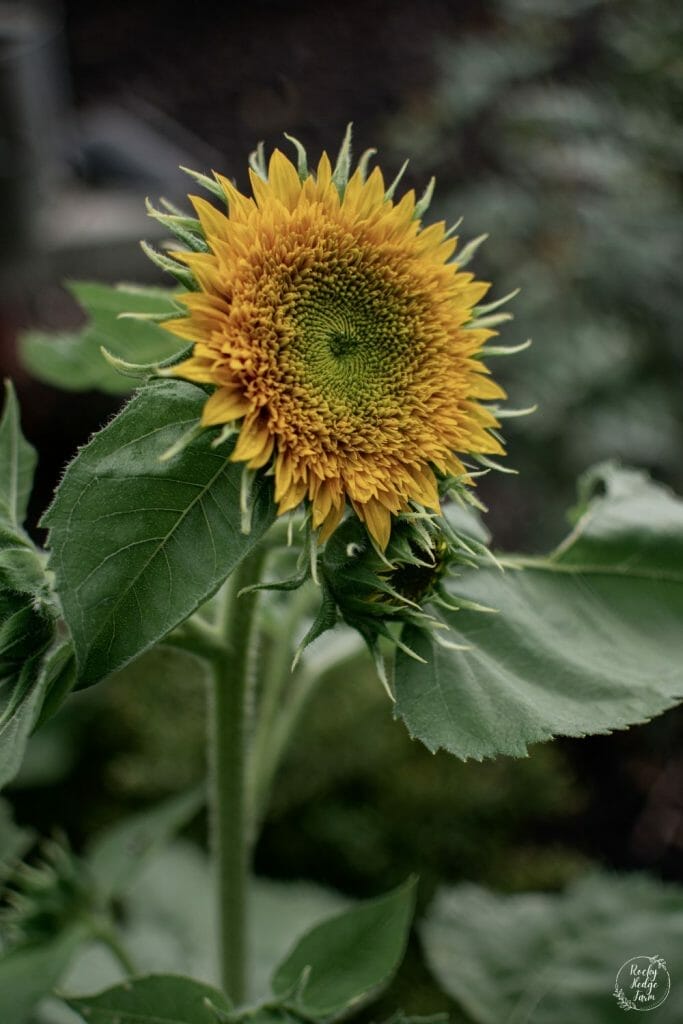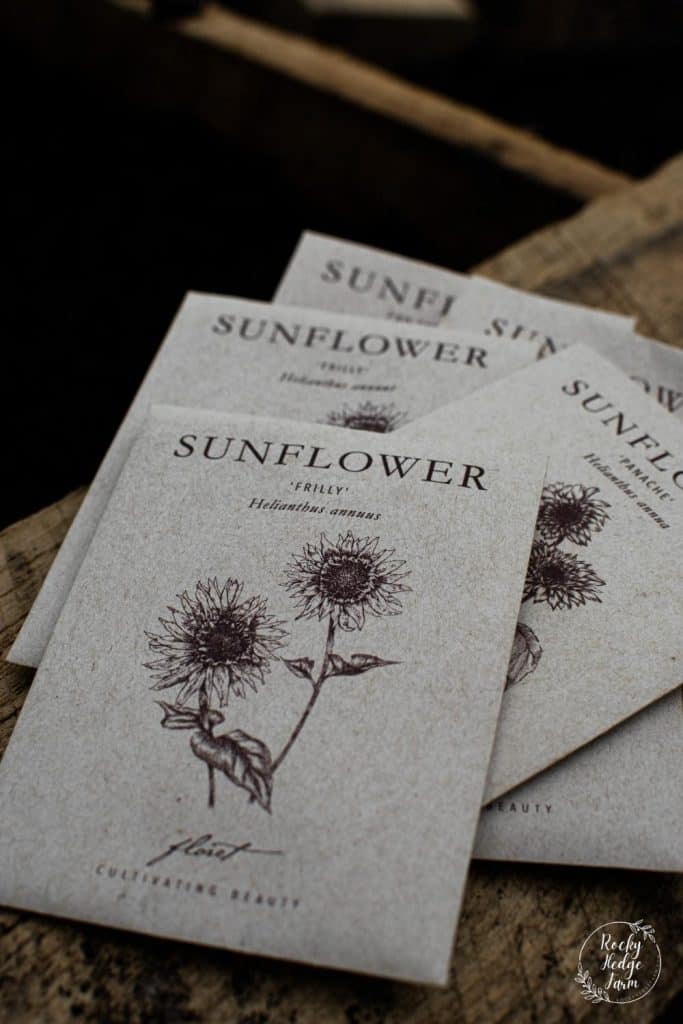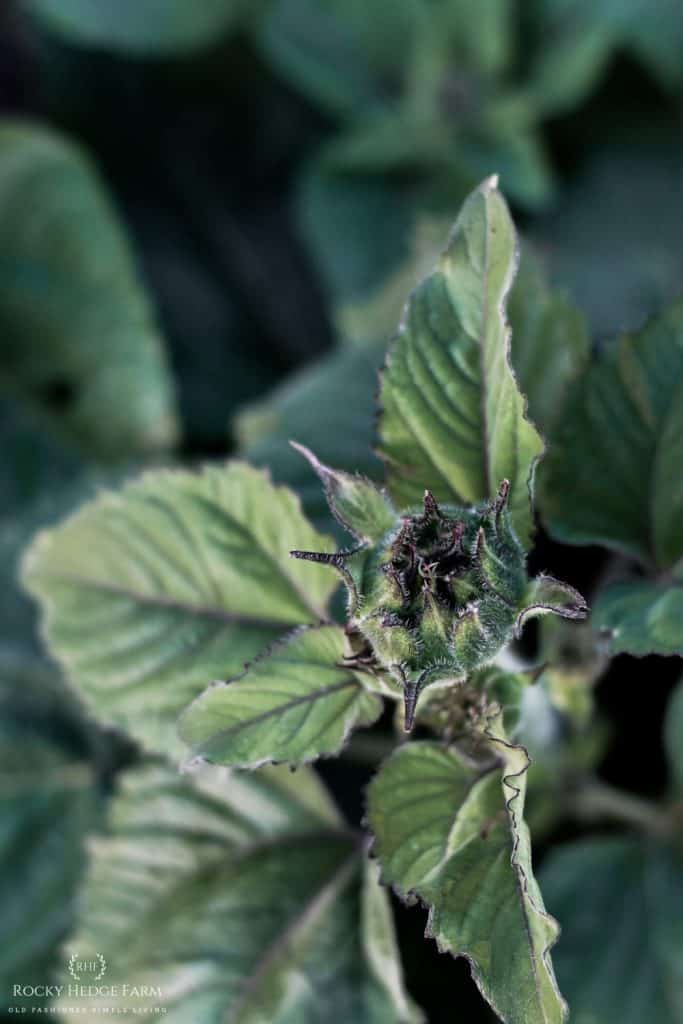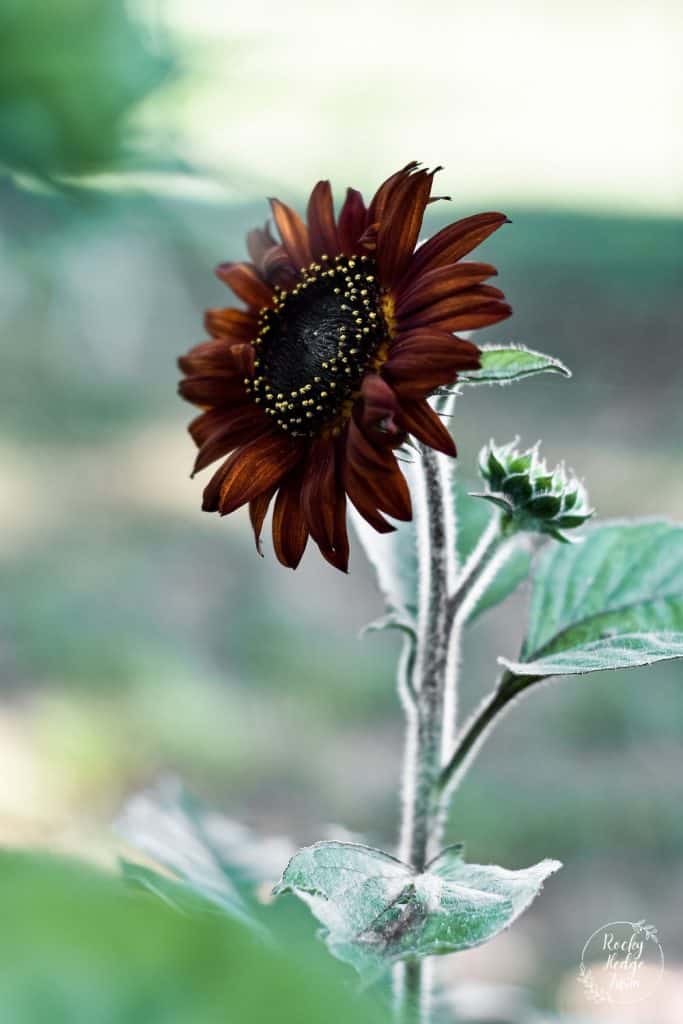This complete guide on how to plant sunflower seeds is broken down into easy step-by-step instructions. Planting sunflower seeds is a rewarding experience.
Sunflower seedlings grow quickly and add life and color to your yard or home garden. This guide teaches how to plant, grow, and care for sunflowers from seeds!

Grow Sunflowers from Seeds
Sunflowers (scientific name Helianthus annuus), are a popular annual garden plant throughout much of North America.
The flowers are familiar in summer meadows, and the dramatic blossoms add an important vertical element to the vegetable garden.

Sunflowers are some of the most popular cut flowers in a cutting garden. They can be seen as the border plant that heightens a flower bed.
But sunflowers are not just a beautiful decorative element. They also provide food for birds and squirrels.
If you’re wondering how to grow sunflowers from seeds in your garden, the best time to plant the seeds, how much sun they need, whether sunflowers come back every year, or how long sunflowers take to grow, then this post is for you!
All you need are these simple tips on growing sunflower seedlings to get the most out of these annual flowers.
Botanical Name: Helianthus annuus
Common Name: Sunflower
Hardiness Zones: 2 to 11
Bloom Time: Most sunflower varieties bloom from midsummer through early fall for several weeks.

Sunflower Growing Tips
Sunflower plants are a great addition to any garden. They’re easy to grow, heat tolerant, mostly pest resistant, and fast-growing.
You can use sunflowers for gorgeous cut flowers, leave them on the stalk for beautiful blooms in your garden, or dry and preserve sunflower heads. You can also harvest them for the seeds.
Here are tips on how to plant sunflower seeds in the ground.
Sunlight
Planting sunflower seedlings in an area with full sun will give the best results for beautiful blooms. Sunflowers love the sun and need to be planted in an area with six to eight hours of direct sunlight per day.
Soil
Sunflowers are heavy feeders and generate the most blooms when planted in nutrient-rich soil. They develop long taproots that grow several feet into the ground.
Sunflower plants prefer well-drained soil with a fine crumbly texture that is weed-free and loose with added compost or other organic matter.
Water
Sunflowers require a lot of water while they’re germinating. To ensure that your sunflowers get the best start, provide them with adequate water daily. Keep the soil moist with regular watering until the seeds start to sprout.
Once the plant is established, deep watering once a week is beneficial to encourage the sunflower roots to grow deep into the ground, especially with taller varieties bearing top-heavy blooms.

Fertilize
Sunflowers need very little granular fertilizer while they are growing. If you prepare your soil with compost and manure, no additional fertilizing will be needed during the growing season.
However, adding some slow-release fertilizer would be a good idea if the soil is poor in nutrients.
Weed Control
One of the most significant challenges to growing sunflowers is weed control. Weeds compete with sunflowers for water and nutrients from the soil.
To prevent weeds, put down a layer of cardboard and then a thick 4″ layer of mulch.
Pests and Diseases
Sunflowers may be a gardener’s favorite plant, but insects also love to feast on them.
Insects like the sunflower moth can cause extensive damage to sunflower plants, but in most cases, the damage is not severe enough to warrant spraying with an insecticide.
Sunflowers rely heavily on pollinators like bees, so limiting any use of insecticides during pollination is essential.
Proper planting spacing in well-draining soil can reduce the risk of Verticillium wilt and other fungal infections, such as rust and powdery mildew.

When to Plant Sunflower Seeds
Choosing when to plant sunflower seeds requires waiting until all danger of frost has passed.
Plant sunflowers in late spring or early summer after the ground has warmed up. Most sunflowers germinate when the soil is between 70-85 degrees Fahrenheit.
How Late Can You Plant Sunflower Seeds
To figure out how late you can plant sunflower seeds, find out the average frost for your area. Use this calculator to find your first and last average frost date and the number of frost-free days.
If, for example, there are 90 days until your first frost, you may still have time to plant a sunflower that matures in approximately 60-65 days or less.

How to Plant Sunflowers Seeds
Growing sunflowers from seeds is a quick and easy task. Learning how to plant sunflower seeds step by step gives these plants the most substantial healthy start.
The variety of sunflower seeds is extensive. Different seeds need different planting methods, too. For the best results, follow the directions on your seed packet for instructions on how to plant your seeds.
The seed packet will contain instructions, the height of the sunflower, days to maturity, the plant spacing suggestion, and any other information about how to grow the seeds.

Step 1: Choose a Location
Sunflowers love the sun. This fast-growing annual plant should be planted in a sunny spot with at least 6 hours of daily sunlight.
Tall sunflowers require a good location for growing. Plant them in a sheltered place from strong wind or along a fence to provide support.
Dwarf varieties of sunflowers are low-growing plants perfect for planting in pots or containers. They are also great for growing along the front border of the garden.
Step 2: Prepare the Soil
These plants prefer loose, well-draining, good soil. Mix in several inches of compost when growing sunflowers from seeds if your soil needs nutrients before planting. An ideal soil pH is between 6.0 and 7.5.

Step 3: Plant Sunflower Seeds at the Right Time
When to plant sunflower seeds will vary depending on where you live. Generally, the best month for planting sunflower seeds in the ground is between March and May once the danger of spring frost has passed.
Plant sunflower seeds in late spring when the soil is warm. Sunflower seeds germinate when the ground reaches 70 to 85 degrees, about 3-4 weeks after the last frost.
Step 4: Plant the Sunflower Seeds in the Ground
How deep to sow seeds and how far apart to space sunflower seeds will depend on your specific sunflower variety.
Sunflower seeds should be planted in a shallow trench about an inch deep. Sow sunflower seeds 6 inches apart.
Once the seedlings have reached 6 inches tall, thin the sunflower plants, leaving the strongest sunflower seedlings about 12-inches apart.
To have continuous blooms all season long, sow sunflowers by staggering your plantings, and sowing a new row of seeds every two weeks.
Smaller varieties of sunflowers can be spaced 6 inches apart. In comparison, giant sunflowers (Mammoth) need 24 inches around the plant.
If planting sunflower seeds in rows, space the rows 2 to 3 feet apart. Sunflower seeds should sprout in 10-14 days.

Step 5: Provide Water
During germination, keep the soil moist with light watering daily until the seeds sprout.
Once the plant is established, deep watering once a week encourages the roots to grow deep into the ground.
Sunflowers are somewhat drought tolerant once established, but they require a lot of water during the germination period.
Healthy sunflowers start with a consistent and generous amount of water.
Step 6: Protect your Sunflower Seeds
Protect newly planted sunflower seeds to keep birds, squirrels, and mice from digging up the seeds.
One option is to use a frost cloth and anchor the corners down to keep the animals away until the sunflower seedlings can root.
Step 7: Pinch Sunflowers for More Blooms
The sunflowers I grow are grown for use as beautiful cut flowers. Rather than growing sunflowers for their height, I grow them to produce cut flowers.
To pinch sunflowers for more blooms, pinch out the growing tip when the sunflower reaches 18″ tall. Within a week, many buds will break from the space between the remaining leaves and central stem.

Where to Buy Sunflower Seeds for Planting
It is effortless to grow sunflowers from seeds, requiring little attention from the gardener. Many of the varieties I grow here at Rocky Hedge Farm are from seeds that I purchase from Floret Farmer or Bakers Creek.
Best Sunflowers to Grow
Here are the sunflowers that I grow for cut flowers!
| Sunflower Type | Description | Plant Details |
|---|---|---|
| Sunflower Frilly | A branching sunflower loaded with glowing spiky petals that surround dark fuzzy centers. | Plant Type: Annual Height: 60-72” Site: full sun Days to maturity: 60-65 days Plant spacing: 12-18” Pinch: when 18” tall |
| Sunflower Greenburst | A branching pollen-less sunflower with golden semi-double petals. | Plant type: annual Height: 60-72” Site: full sun Days to maturity: 60-70 days Plant spacing: 12-18” Pinch: when 18” tall |
| Sunflower Pro Cut White Lite | Tall ivory-petaled flowers with honey mustard centers. This single flower stemmed variety is pollenless and is grown for cut flower production. | Plant type: annual Height: 60-72” Site: full sun Days to maturity: 60-65 days Plant spacing: 6-9” Pinch: not necessary |
| Red Sun Sunflower | Red to red-orange single flowers with a hint of yellow around the centers. Blooms over a very long season, attracting bees and butterflies. Later, the tiny seeds attract birds. | 8-12 hours of sun Sprouts in 7-14 days Ideal Temperature: 60-75 Degrees F Seed Depth: 1/2″ Plant Spacing: 18-24″ Frost Hardy: No |

Harvesting Sunflower Seeds
Sunflowers have always been a beautiful addition to the landscape, but harvesting sunflower seeds are a delicious and rewarding way to use them.
Their seeds are a healthy and nutritious snack, which can be saved to replant the following year in the garden. If you are growing sunflowers to keep the seed, follow these steps:
Protect the Seeds: When the flower heads have matured, and the petals have fallen off, cover the seed heads with cheesecloth or a paper bag. This will help avoid unwanted birds and squirrels from eating the seeds.
Let the sunflower head dry. Wait until the back of the sunflower head turns brown, and the seeds are plump before harvesting.
Remove the sunflower head. Cut the head off the plant leaving about 6 inches of stem. Place the head in a container to catch loose seeds.
Remove the seeds: Brush the seeds out with your hands, knocking out the seeds.
Save the seeds: Store sunflower seeds in an airtight container in a cool, dry place to keep them as fresh as possible.

Frequently Asked Questions About Growing Sunflowers from Seeds
Sunflowers are a cheerful and productive addition to any garden. They are easy to grow, requiring little more than ample sun and water.
Here are several frequently asked questions regarding how to plant sunflowers seeds
Do Sunflowers Need to be Supported?
It depends on the height of the sunflowers. Tall varieties like Mammoth Sunflower need additional support with stakes or poles to keep them from falling over.
Can I Grow Sunflowers in Pots?
Dwarf varieties of low-growing sunflowers, like teddy bear are great for growing in a pot. Sunflowers between 12 inches and three feet tall are ideal for containers.
How Long do Sunflowers Take to Grow from Seeds
There are wide varieties of sunflowers; depending on the variety, it takes about 60 to 120 days for the plant to mature and produce seeds, on average.
What Month Do You Plant Sunflowers?
Late spring until early summer is the best time to plant sunflowers seeds directly into the garden after all danger of frost has passed.
In most areas, this is between April and May up until July after the soil warms to at least 60 degrees.
How Long Does it Take Sunflowers to Sprout from Seeds?
Sunflower seeds will sprout in 10-14 days with an optimal soil temperature of 70-85 degrees.
Should I Soak Sunflower Seeds Before Planting?
Before planting them directly into your garden, you do not need to soak sunflower seeds.
Do Sunflowers Grow Back Every Year?
Sunflowers are an annual, and they need to be replanted every year.
How Tall do Sunflowers Grow?
The tallest sunflower varieties grow to 16 feet tall, while the small varieties are designed for small spaces and containers. These flowers rarely grow larger than a foot in height.
Why do Sunflowers Turn Toward the Sun?
Heliotropism is a term used to describe sunflowers’ orientation regarding the sun’s movement.
Young sunflowers exhibit heliotropism, meaning their flowering heads track the sun as it moves across the sky.
As the stem matures, the tracking usually becomes less noticeable.

When the sunflowers are in full bloom, it’s hard not to feel happy. They symbolize summer and are one of the most beautiful flowers you’ll ever see.
I hope you have found some helpful tips on planting sunflower seeds. Whether you’re getting ready for your garden this year or planning to add sunflowers next year, here’s to wishing you a garden full of beautiful sunflowers!



I would love to grow sunflowers. Pinned it so next year I can see about growing some, thank you.